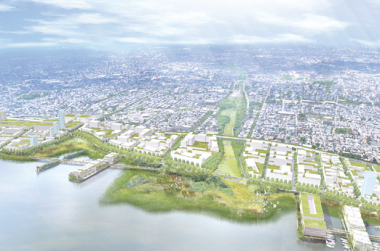
Damien Hirst’s “Golden Calf” sold for $18.6 million last year, but the art climate has changed.
By HOLLAND COTTER
LAST year Artforum magazine, one of the country’s leading contemporary art monthlies, felt as fat as a phone book, with issues running to 500 pages, most of them gallery advertisements. The current issue has just over 200 pages. Many ads have disappeared.
The contemporary art market, with its abiding reputation for foggy deals and puffy values, is a vulnerable organism, traditionally hit early and hard by economic malaise. That’s what’s happening now. Sales are vaporizing. Careers are leaking air. Chelsea rents are due. The boom that was is no more.
Anyone with memories of recessions in the early 1970s and late ’80s knows that we’ve been here before, though not exactly here. There are reasons to think that the present crisis is of a different magnitude: broader and deeper, a global black hole. Yet the same memories will lend a hopeful spin to that thought: as has been true before, a financial scouring can only be good for American art, which during the present decade has become a diminished thing.
The diminishment has not, God knows, been quantitative. Never has there been so much product. Never has the American art world functioned so efficiently as a full-service marketing industry on the corporate model.
Every year art schools across the country spit out thousands of groomed-for-success graduates, whose job it is to supply galleries and auction houses with desirable retail. They are backed up by cadres of public relations specialists — otherwise known as critics, curators, editors, publishers and career theorists — who provide timely updates on what desirable means.
Many of those specialists are, directly or indirectly, on the industry payroll, which is controlled by another set of personnel: the dealers, brokers, advisers, financiers, lawyers and — crucial in the era of art fairs — event planners who represent the industry’s marketing and sales division. They are the people who scan school rosters, pick off fresh talent, direct careers and, by some inscrutable calculus, determine what will sell for what.
Not that these departments are in any way separated; ethical firewalls are not this industry’s style. Despite the professionalization of the past decade, the art world still likes to think of itself as one big Love Boat. Night after night critics and collectors scarf down meals paid for by dealers promoting artists, or museums promoting shows, with everyone together at the table, schmoozing, stroking, prodding, weighing the vibes.
And where is art in all of this? Proliferating but languishing. “Quality,” primarily defined as formal skill, is back in vogue, part and parcel of a conservative, some would say retrogressive, painting and drawing revival. And it has given us a flood of well-schooled pictures, ingenious sculptures, fastidious photographs and carefully staged spectacles, each based on the same basic elements: a single idea, embedded in the work and expounded in an artist’s statement, and a look or style geared to be as catchy as the hook in a rock song.
The ideas don’t vary much. For a while we heard a lot about the radicalism of Beauty; lately about the subversive politics of aestheticized Ambiguity. Whatever, it is all market fodder. The trend reached some kind of nadir on the eve of the presidential election, when the New Museum trotted out, with triumphalist fanfare, an Elizabeth Peyton painting of Michelle Obama and added it to the artist’s retrospective. The promotional plug for the show was obvious. And the big political statement? That the art establishment voted Democratic.
Art in New York has not, of course, always been so anodyne an affair, and will not continue to be if a recession sweeps away such collectibles and clears space for other things. This has happened more than once in the recent past. Art has changed as a result. And in every case it has been artists who have reshaped the game.
The first real contemporary boom was in the early 1960s, when art decisively stopped being a coterie interest and briefly became an adjunct to the entertainment industry. Cash was abundant. Pop was hot. And the White House was culture conscious enough to create the National Endowment for the Arts so Americans wouldn’t keeping looking, in the words of Arthur Schlesinger Jr., like “money-grubbing materialists.”
The boom was short. The Vietnam War and racism were ripping the country apart. The economy tanked. In the early ’70s New York City was on the verge of bankruptcy, bleeding money and jobs. With virtually no commercial infrastructure for experimental art in place, artists had to create their own marginal, bootstrap model.
They moved, often illegally, into the derelict industrial area now called SoHo, and made art from what they found there. Trisha Brown choreographed dances for factory rooftops; Gordon Matta-Clark turned architecture into sculpture by slicing out pieces of walls. Everyone treated the city as a found object.
An artist named Jeffrey Lew turned the ground floor of his building at 112 Greene Street into a first-come-first-served studio and exhibition space. People came, working with scrap metal, cast-off wood and cloth, industrial paint, rope, string, dirt, lights, mirrors, video. New genres — installation, performance — were invented. Most of the work was made on site and ephemeral: there one day, gone the next.
White Columns, as 112 Greene Street came to called, became a prototype for a crop of nonprofit alternative spaces that sprang up across the country. Recessions are murder on such spaces, but White Columns is still alive and settled in Chelsea with an exhibition, through the end of the month, documenting, among other things, its 112 Greene Street years.
The ’70s economy, though stagnant, stabilized, and SoHo real estate prices rose. A younger generation of artists couldn’t afford to live there and landed on the Lower East Side and in South Bronx tenements. Again the energy was collective, but the mix was different: young art-school graduates (the country’s first major wave ), street artists like Jean-Michel Basquiat and Fab Five Freddy Braithwaite, assorted punk-rebel types like Richard Hell and plain rebels like David Wojnarowicz.
Here too the aesthetic was improvisatory. Everybody did everything — painting, writing, performing, filming, photocopying zines, playing in bands — and new forms arrived, including hip-hop, graffiti, No Wave cinema, appropriation art and the first definable body of “out” queer art. So did unusual ways of exhibiting work: in cars, in bathrooms, in subways.
The best art was subversive, but in very un-’60s, nonideological ways. When, at midnight, you heard Klaus Nomi, with his bee-stung black lips and robot hair, channeling Maria Callas at the Mudd Club, you knew you were in the presence of a genius deviant whose very life was a political act.
But again the moment was brief. The Reagan economy was creating vast supplies of expendable wealth, and the East Village became a brand name. Suddenly galleries were filled with expensive, tasty little paintings and objects similar in variety and finesse to those in Chelsea now. They sold. Limousines lined up outside storefront galleries. Careers soared. But the originating spark was long gone.
After Black Monday in October 1987 the art was gone too, and with the market in disarray and gatekeepers confused, entrenched barriers came down. Black, Latino and Asian-American artists finally took center stage and fundamentally redefined American art. Gay and lesbian artists, bonded by the AIDS crisis and the culture wars, inspired by feminism, commanded visibility with sophisticated updates on protest art.
And thanks to multiculturalism and to the global reach of the digital revolution, the American art world in the ’90s was in touch with developments in Africa, Asia and South America. For the first time contemporary art was acknowledged to be not just a Euro-American but an international phenomenon and, as it soon turned out, a readily marketable one.
Which brings us to the present decade, held aloft on a wealth-at-the-top balloon, threatening to end in a drawn-out collapse. Students who entered art school a few years ago will probably have to emerge with drastically altered expectations. They will have to consider themselves lucky to get career breaks now taken for granted: the out-of-the-gate solo show, the early sales, the possibility of being able to live on the their art.
It’s day-job time again in America, and that’s O.K. Artists have always had them — van Gogh the preacher, Pollock the busboy, Henry Darger the janitor — and will again. The trick is to try to make them an energy source, not a chore.
At the same time, if the example of past crises holds true, artists can also take over the factory, make the art industry their own. Collectively and individually they can customize the machinery, alter the modes of distribution, adjust the rate of production to allow for organic growth, for shifts in purpose and direction. They can daydream and concentrate. They can make nothing for a while, or make something and make it wrong, and fail in peace, and start again.
Art schools can change too. The present goal of studio programs (and of ever more specialized art history programs) seems to be to narrow talent to a sharp point that can push its way aggressively into the competitive arena. But with markets uncertain, possibly nonexistent, why not relax this mode, open up education?
Why not make studio training an interdisciplinary experience, crossing over into sociology, anthropology, psychology, philosophy, poetry and theology?
Why not build into your graduate program a work-study semester that takes students out of the art world entirely and places them in hospitals, schools and prisons, sometimes in-extremis environments, i.e. real life? My guess is that if you did, American art would look very different than it does today.
Such changes would require new ways of thinking and writing about art, so critics will need to go back to school, miss a few parties and hit the books and the Internet. Debate about a “crisis in criticism” gets batted around the art world periodically, suggesting nostalgia for old-style traffic-cop tastemakers like Clement Greenberg who invented movements and managed careers. But if there is a crisis, it is not a crisis of power; it’s a crisis of knowledge. Simply put, we don’t know enough, about the past or about any cultures other than our own.
A globally minded learning curve that started to grow in the 1980s and ’90s seems to have withered away once multiculturalism fell out of fashion. Some New York critics, with a sigh of relief one sensed, have gone back to following every twitch of the cozy local scene, which also happens to constitute their social life.
The subject is not without interest, but it’s small. In the 21st century New York is just one more art town among many, and no longer a particularly influential one. Contemporary art belongs to the world. And names of artists only half-familiar to us — Uzo Egonu, Bhupen Khakhar, Iba Ndiaye, Montien Boonma, Amrita Sher-Gil, Graciela Carnevale, Madiha Omar, Shakir Hassan Al Said — have as much chance of being important to history as many we know.
But there will be many, many changes for art and artists in the years ahead. Trying to predict them is like trying to forecast the economy. You can only ask questions. The 21st century will almost certainly see consciousness-altering changes in digital access to knowledge and in the shaping of visual culture. What will artists do with this?
Will the art industry continue to cling to art’s traditional analog status, to insist that the material, buyable object is the only truly legitimate form of art, which is what the painting revival of the last few years has really been about? Will contemporary art continue to be, as it is now, a fancyish Fortunoff’s, a party supply shop for the Love Boat crew? Or will artists — and teachers, and critics — jump ship, swim for land that is still hard to locate on existing maps and make it their home and workplace?
I’m not talking about creating ’60s-style utopias; all those notions are dead and gone and weren’t so great to begin with. I’m talking about carving out a place in the larger culture where a condition of abnormality can be sustained, where imagining the unknown and the unknowable — impossible to buy or sell — is the primary enterprise. Crazy! says anyone with an ounce of business sense.
Right. Exactly. Crazy.
Fuente: NYT







